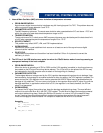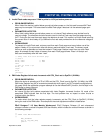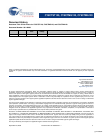
CY8CTST120, CY8CTMG120, CY8CTMA120
September 25, 2008 Document No. 001-49038 Rev. ** 2
1. Internal Main Oscillator (IMO) tolerance deviation at temperature extremes.
PROBLEM DEFINITION
Asynchronous digital communication interfaces may fail framing beyond 0 to 70°C. This problem does not
affect end product usage between 0 and 70°C.
PARAMETERS AFFECTED
The IMO frequency tolerance. The worst case deviation when operated below 0°C and above +70°C and
within the upper and lower data sheet temperature range is ±5%.
TRIGGER CONDITION
The asynchronous Rx/Tx clock source IMO frequency tolerance may deviate beyond the data sheet limit
of ±4% when operated beyond the temperature range of 0 to +70°C.
SCOPE OF IMPACT
This problem may affect UART, IrDA, and FSK implementations.
WORKAROUND
Implement a quartz crystal stabilized clock source on at least one end of the asynchronous digital
communications interface.
FIX STATUS
The cause of this problem and its solution has been identified. Silicon fix is planned to correct the
deficiency in silicon.
2. The DP line of the USB interface may pulse low when the PSoC® device wakes from sleep causing an
unexpected wakeup of the host computer
PROBLEM DEFINITION
When the device is operating at 4.75V to 5.25V and the 3.3V regulator is enabled, a short low pulse may
be created on the DP signal line during device wakeup. The 15 µs to 20 µs low pulse of the DP line may
be interpreted by the host computer as a de-attach or the beginning of a wakeup.
PARAMETERS AFFECTED
The bandgap reference voltage used by the 3.3V regulator decreases during sleep due to leakage. Upon
device wakeup, the bandgap is re-enabled and after a delay for settling, the 3.3V regulator is enabled. On
some devices the 3.3V regulator that is used to generate the USB DP signal may be enabled before the
bandgap is fully stabilized. This can cause a low pulse on the regulator output and DP signal line until the
bandgap stabilizes. In applications where Vdd is 3.3V, the regulator is not used; therefore, the DP low
pulse is not generated.
WORKAROUND
To prevent the DP signal from pulsing low, keep the bandgap enabled during sleep. The most efficient
method is to set the No Buzz bit in the OSC_CR0 register. The No Buzz bit keeps the bandgap powered
and output stable during sleep. Setting the No Buzz bit results in a nominal 100 µA increase to sleep
current. Leaving the analog reference block enabled during sleep also resolves this issue because it
forces the bandgap to remain enabled. An example to disable the No Buzz bit is as follows.
Assembly
M8C_SetBank1
or reg[OSC_CR0], 0x20
M8C_SetBank0
C
OSC_CR0 |= 0x20;
[+] Feedback







